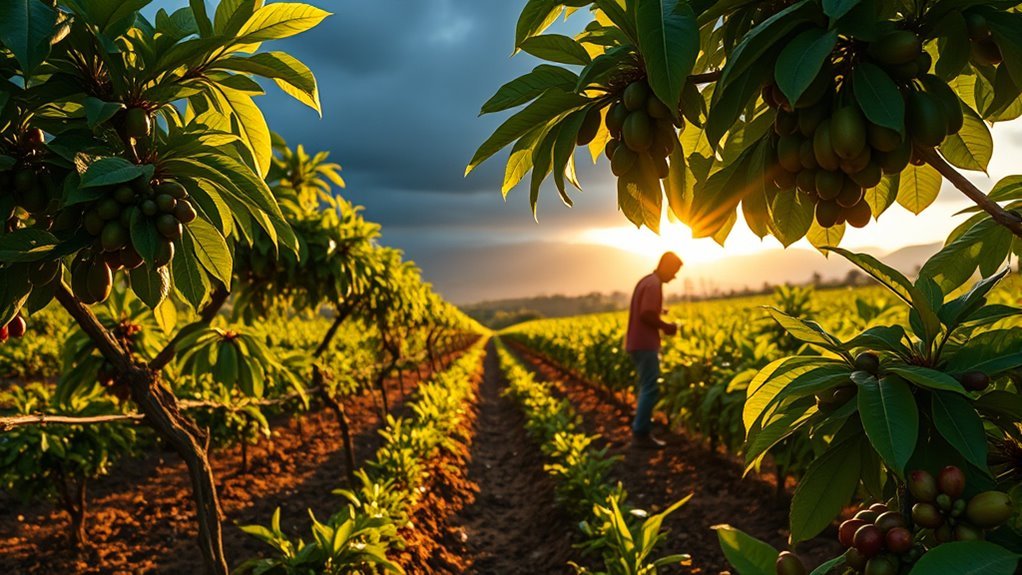Exploring Sustainable Coffee Farming Practices
If you want to improve your coffee yield sustainably, consider shade-grown methods that enhance biodiversity, reduce pests naturally, and improve soil stability. Use organic fertilizers to boost nutrient cycling and support microbial health without synthetic inputs. Integrate water-saving techniques like drip irrigation and mulching while applying pest management via biological controls and botanical insecticides. Coupling these with agroforestry systems can stabilize microclimates and enrich soils. By exploring these approaches, you’ll discover deeper strategies that benefit both your farm and the environment.
Benefits of Shade-Grown Coffee

Although shade-grown coffee requires more careful management than sun-grown varieties, its benefits are well-documented regarding biodiversity conservation, soil health, and coffee quality. You’ll find that shade grown advantages include enhanced habitat diversity, supporting a variety of fauna and flora often absent in monoculture plantations. This ecological impact reduces pest outbreaks naturally, minimizing chemical inputs. Additionally, shade trees improve soil stability by reducing erosion and maintaining moisture, which preserves nutrient cycles essential for sustainable yield. Studies indicate that coffee produced under shade exhibits superior flavor profiles, attributed to slower maturation and stress regulation. By adopting shade-grown methods, you’re not only promoting ecological balance but also fostering resilient farming systems that align with your pursuit of freedom from environmentally detrimental practices.
Organic Fertilizers in Coffee Cultivation
When you incorporate organic fertilizers into coffee cultivation, you engage in a practice that enhances soil fertility through natural nutrient cycling and microbial activity. By leveraging composting techniques, you recycle organic waste into nutrient-rich amendments that improve soil structure and moisture retention. This method supports the diverse microbial communities essential for nutrient availability, reducing dependency on synthetic inputs.
Incorporating organic fertilizers enriches coffee soil naturally, boosting fertility and reducing reliance on synthetic chemicals.
Key considerations include:
- Utilizing well-decomposed compost to guarantee nutrient stability
- Balancing carbon-to-nitrogen ratios for efficient decomposition
- Applying organic matter consistently to sustain nutrient cycling
- Monitoring soil pH to optimize microbial efficacy
- Integrating mulching to protect soil and retain nutrients
Adopting these strategies empowers you to maintain a resilient coffee agroecosystem, promoting sustainable productivity and ecological freedom.
Water Conservation Techniques for Coffee Farms
You can greatly reduce water waste on your coffee farm by implementing efficient irrigation methods like drip systems, which deliver water directly to the plant roots with minimal evaporation. Additionally, harvesting rainwater provides a sustainable supplemental water source, lowering reliance on groundwater and improving water availability during dry periods. These techniques not only conserve water but also enhance crop yield stability under variable climatic conditions.
Efficient Irrigation Methods
How can coffee farmers optimize water use without compromising crop yield? Implementing efficient irrigation methods is key. Drip irrigation delivers water directly to the root zone, reducing evaporation and runoff. Coupled with moisture sensors, you can monitor soil water levels in real-time, ensuring irrigation only when necessary. This precision prevents overwatering and conserves water resources.
Consider these strategies to enhance irrigation efficiency:
- Install drip irrigation systems tailored to coffee plant spacing
- Use moisture sensors for dynamic irrigation scheduling
- Employ automated valves linked to soil moisture data
- Regularly maintain irrigation infrastructure to avoid leaks
- Integrate mulching to retain soil moisture and reduce irrigation frequency
Rainwater Harvesting Benefits
Why prioritize rainwater harvesting on your coffee farm? Efficient rainwater storage reduces dependency on groundwater and municipal supplies, enhancing your farm’s resilience against drought and fluctuating water costs. Implementing effective rainwater filtration systems guarantees that the collected water is free from contaminants, enabling safe irrigation that maintains coffee plant health. Research shows that farms utilizing harvested rainwater can decrease water usage by up to 40%, promoting sustainability without sacrificing yield. By capturing and storing rainwater, you gain greater control over water availability, empowering your operation to thrive independently. Integrating rainwater harvesting aligns with eco-friendly practices, reduces runoff and erosion, and supports long-term soil moisture management. Ultimately, this technique not only conserves water but also strengthens your farm’s autonomy and environmental stewardship.
Agroforestry Systems Supporting Coffee Growth
You’ll find that integrating shade trees into your coffee farm improves microclimate regulation, which enhances bean quality and yield. These trees also act as critical habitats, boosting local biodiversity and promoting ecosystem resilience. Research shows that agroforestry systems can reduce pest outbreaks and improve soil health, making them a sustainable choice for coffee cultivation.
Shade Trees Benefits
What advantages do shade trees provide within agroforestry systems for coffee cultivation? Incorporating a shade canopy is essential for maintaining ecological balance, regulating microclimate, and enhancing coffee plant resilience. Shade trees moderate temperature extremes and reduce water stress, optimizing photosynthesis and bean quality. They also improve soil structure through organic matter inputs and nutrient cycling, decreasing erosion risk.
Key benefits include:
- Stabilization of microclimate via shade canopy, reducing heat stress
- Enhanced soil fertility through leaf litter decomposition
- Improved water retention and reduced evapotranspiration
- Carbon sequestration contributing to climate regulation
- Pest and disease moderation by supporting natural predator habitats
Biodiversity Enhancement
Building on the role of shade trees in regulating microclimates and improving soil conditions, agroforestry systems also greatly boost biodiversity within coffee plantations. By integrating native species into your farm, you actively promote habitat preservation, providing refuge for various flora and fauna. These systems create complex vertical and horizontal structures that support diverse organisms, enhancing ecological resilience. Studies demonstrate that coffee farms maintaining native shade trees host markedly higher species richness, including pollinators and natural pest predators, which can reduce reliance on chemical inputs. Additionally, preserving native habitats within agroforestry frameworks helps maintain genetic diversity critical for ecosystem adaptability. If you embrace these practices, you’ll foster a more balanced environment that sustains coffee productivity and protects biodiversity, empowering you to manage your land with ecological integrity and long-term sustainability.
Pest Management Without Harmful Chemicals
Although chemical pesticides offer quick solutions to pest problems, they often cause long-term environmental damage and harm beneficial organisms. You can adopt pest management without harmful chemicals by implementing integrated pest management (IPM) strategies that emphasize ecological balance. Biological control, using natural predators or parasites, is a cornerstone of this approach, reducing pest populations sustainably.
Chemical pesticides harm ecosystems; integrated pest management uses natural predators to sustain pest control.
Key practices include:
- Introducing predatory insects like ladybugs to control aphids
- Employing pheromone traps to disrupt pest mating cycles
- Utilizing resistant coffee plant varieties to minimize vulnerability
- Applying botanical insecticides derived from neem or pyrethrum
- Monitoring pest populations regularly to apply targeted interventions
Enhancing Soil Health Through Crop Rotation

You can improve soil health by implementing crop rotation, which reduces nutrient depletion and disrupts pest cycles. Incorporating common rotation crops like legumes enhances nitrogen fixation and organic matter content. Effective soil nutrient management through rotation supports sustainable coffee yields and long-term farm productivity.
Benefits of Crop Rotation
When you integrate crop rotation into coffee farming, you reduce soil nutrient depletion by alternating crops with different nutrient demands. This practice leverages the diversity benefits of various plants, improving soil structure and fertility over time. Proper rotation timing is critical; it prevents pest cycles and enhances microbial activity, optimizing nutrient availability for coffee plants. By systematically changing crops, you maintain a balanced ecosystem that supports sustainable yields.
Key benefits include:
- Enhanced soil nutrient cycling and retention
- Disruption of pest and disease life cycles
- Improved soil organic matter content
- Increased microbial diversity and activity
- Reduced reliance on chemical fertilizers
These advantages collectively empower you to cultivate coffee more sustainably while preserving soil health and long-term productivity.
Common Rotation Crops
Building on the benefits of crop rotation, selecting appropriate rotation crops plays a significant role in enhancing soil health specifically for coffee farming systems. You’ll find that integrating leguminous crop varieties, such as beans and peas, effectively fixes atmospheric nitrogen, boosting soil fertility naturally. Additionally, incorporating cover crops like clover or vetch protects against erosion and improves organic matter content. When you design intercropping systems, combining coffee with shade trees or certain fruit trees further diversifies the cropping structure, promoting pest regulation and microclimate stabilization. Evidence indicates that rotating with deep-rooted crops can also alleviate soil compaction, enhancing water infiltration. By carefully choosing rotation crops based on functional traits and compatibility within intercropping systems, you optimize nutrient cycling and maintain soil resilience, ultimately supporting sustainable coffee production and preserving your farm’s long-term productivity.
Soil Nutrient Management
Although crop rotation is widely recognized for its role in pest and disease management, its impact on soil nutrient dynamics is equally critical for sustainable coffee farming. You’ll find that rotating crops influences soil pH and enhances nutrient cycling, ultimately boosting soil fertility. By alternating coffee with legumes or cover crops, you replenish nitrogen and balance essential minerals, reducing reliance on synthetic fertilizers. This practice also promotes microbial diversity, which accelerates organic matter decomposition and nutrient availability.
Key benefits of crop rotation for soil nutrient management include:
- Stabilizing soil pH to optimize nutrient uptake
- Enhancing nitrogen fixation via leguminous plants
- Preventing nutrient depletion through varied root systems
- Improving organic matter content and soil structure
- Supporting diverse microbial communities for efficient nutrient cycling
Implementing these strategies secures long-term soil health and sustainable yields.
The Role of Fair Trade in Sustainable Coffee
Because fair trade certification establishes stringent social, economic, and environmental standards, it plays a critical role in promoting sustainable coffee farming. When you choose fair trade, you support economic empowerment by guaranteeing farmers a minimum price, reducing their vulnerability to market fluctuations. This framework enforces social responsibility, ensuring safe working conditions and prohibiting child labor. Additionally, fair trade premiums fund community support projects—like education and healthcare—that enhance local resilience. Empirical studies reveal that fair trade-certified farms often adopt more sustainable environmental practices, driven by certification requirements. By prioritizing fair trade coffee, you directly contribute to a system that balances profitability with ethical labor and ecological stewardship, enabling farmers to maintain autonomy while fostering long-term sustainability in coffee production. This approach aligns with your desire for freedom and equitable economic participation.
Renewable Energy Use on Coffee Plantations
When coffee plantations integrate renewable energy sources such as solar, wind, or biomass, they greatly reduce their carbon footprint and operational costs. By installing solar panels and wind turbines, you tap into clean energy that powers irrigation, processing, and storage efficiently. Evidence shows this approach enhances energy independence and resilience against fluctuating fuel prices. Consider these benefits:
- Decreased reliance on fossil fuels
- Lower greenhouse gas emissions
- Consistent power supply for critical operations
- Cost savings over long-term energy expenditure
- Enhanced sustainability credentials for market differentiation
Community Engagement and Farmer Education

Engaging local communities and educating farmers play an essential role in advancing sustainable coffee farming practices. By participating in community workshops, you gain access to data-driven techniques that improve yield while minimizing environmental impact. These workshops facilitate knowledge exchange on soil conservation, pest management, and water efficiency. Farmer cooperatives further empower you by pooling resources and negotiating better market terms, enhancing economic resilience. Evidence shows that cooperative members adopt sustainable methods more rapidly due to shared expertise and collective action. This collaboration not only improves farm productivity but also strengthens social capital, fostering autonomy and freedom in decision-making. Ultimately, your active involvement in these educational and communal structures accelerates the shift to sustainable coffee production, ensuring long-term ecological balance and economic viability.
Innovations in Coffee Waste Recycling
Building on the collaborative efforts in community engagement and farmer education, innovations in coffee waste recycling present promising avenues to enhance sustainability. By focusing on coffee byproducts utilization, you can reduce environmental impact and generate economic value. Advances include converting coffee pulp into biofertilizers, extracting antioxidants for cosmetics, and developing sustainable packaging solutions from coffee husks. These methods not only minimize waste but also promote circular economies within coffee-growing regions. Consider these cutting-edge applications:
- Biochar production from coffee grounds to improve soil health
- Biodegradable packaging derived from coffee husks
- Extraction of bioactive compounds for pharmaceuticals
- Use of coffee pulp in animal feed formulations
- Fermentation techniques transforming waste into bioenergy
Adopting these innovations empowers you to contribute to a sustainable, waste-conscious coffee industry.
Frequently Asked Questions
How Does Altitude Affect Coffee Bean Flavor Profiles?
You’ll find that altitude influence is essential in shaping coffee bean flavor profiles. Higher altitudes, typically above 1,200 meters, slow bean maturation, enhancing flavor complexity with brighter acidity and intricate floral or fruity notes. Lower altitudes produce beans with simpler, earthier flavors due to faster growth. This evidence-based correlation helps you select coffee based on desired taste characteristics, granting you the freedom to explore diverse, nuanced brews shaped by elevation.
What Are the Economic Challenges for Small-Scale Coffee Farmers?
Did you know over 70% of global coffee is produced by small-scale farmers? You face significant economic challenges, like limited market access, which restricts your ability to sell at fair prices. Price volatility further complicates income stability, as coffee prices can fluctuate dramatically due to global supply and demand shifts. These factors make financial planning tough, limiting your freedom to invest in improvements or diversify income sources, ultimately impacting your livelihood’s sustainability.
Which Coffee Varieties Are Most Resilient to Climate Change?
When choosing coffee varieties for climate resilience, you’ll find arabica resilience and robusta adaptability essential. Arabica offers higher quality but is less tolerant to temperature rises and drought, while robusta thrives in hotter, wetter conditions with better resistance to pests and diseases. Evidence shows robusta’s adaptability makes it a strategic choice for unpredictable climates, but you might prefer arabica if you’re aiming for premium quality despite its vulnerability. Balancing these traits helps you secure your coffee’s future.
How Does Coffee Harvesting Impact Local Wildlife?
You’ll find that coffee harvesting impacts wildlife habitats primarily through the methods used. Traditional selective picking tends to preserve canopy cover, supporting biodiversity. However, mechanized or clear-cut harvesting disrupts habitats, reducing shelter and food sources for local species. Analyzing harvesting techniques reveals that less invasive methods maintain ecosystem balance, allowing wildlife to thrive. So, choosing appropriate harvesting approaches is essential if you want to protect local wildlife and promote ecological freedom on coffee farms.
What Certifications Ensure Coffee Sustainability Beyond Organic Labeling?
When you’re evaluating coffee sustainability, you shouldn’t rely solely on organic labels. Certification standards like Rainforest Alliance, Fair Trade, and UTZ integrate thorough sustainability metrics, covering environmental impact, social equity, and economic viability. These certifications provide evidence-based frameworks ensuring responsible farming beyond organic practices. By understanding these standards, you gain freedom to choose coffee that meets rigorous sustainability criteria, supporting both ecological health and fair labor conditions effectively.






